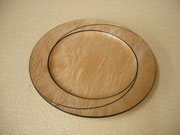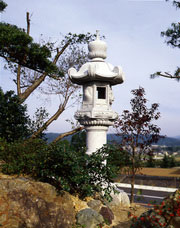Aomori and more
- Sort by
- Popularity
- Name
-
Mino ware Mino yaki
- Ceramic
- Gifu

Mino ware (called Mino yaki in Japanese) is a ceramic ware produced in the Tono area of Gifu prefecture. It has a long history and tradition but has adapted to modern life style. A notable feature of Mino ware is its wide variety of pottery. Mino …
View more
-
Tokoname ware Tokoname yaki
- Ceramic
- Aichi

Tokoname ware (Tokoname yaki in Japanese) is a form of ceramic pottery that is produced in the area around the city of Tokoname in Aichi prefecture. This traditional craft comes from one of the Six Ancient Kilns of Japan. Along with Bizen, Tamba, …
View more
-
Mino traditional Japanese paper Mino washi
- Traditional Japanese paper
- Gifu

Mino washi is a type of Japanese paper made in Gifu prefecture. Washi is made from paper mulberry which is a plant that grows in the city of Mino, a place of abundant forests. Ancient manuscripts in the Shosoin Repository* indicate the history of …
View more
-
Tsugaru lacquerware Tsugaru nuri
- Lacquerware
- Aomori

Tsugaru lacquerware (called tsugaru nuri in Japanese) is produced around the city of Hirosaki in Aomori prefecture. Lacquerware has been produced in this region since the middle of the Edo period (1603-1868), but it began to be called Tsugaru lacq…
View more
-
Takaoka copperware Takaoka doki
- Metal works
- Toyama

Takaoka copperware (called Takaoka doki in Japanese) is a type of copperware produced in the area around the city of Takaoka in Toyama prefecture. The various products range from small items such as indoor ornaments, Buddhist tools, and vases to l…
View more
-
Inami wood carvings Inami chokoku
- Wood, bamboo crafts
- Toyama

Inami woodcarvings (called Inami chokoku in Japanese) are produced in the city of Nanto, Toyama prefecture mainly in the form of transoms*, decorative objects, and single-leaf screens**. They are usually made of Japanese camphor, paulownia, or zel…
View more
-
Boshu uchiwa fans Boshu uchiwa
- Other crafts
- Chiba

Boshu uchiwa is a type of fan made in the areas around the cities of Tateyama and Minamiboso in Chiba prefecture. This is one of Japan’s big three uchiwa types, with the other two being Marugame (Kagawa prefecture) and Kyo uchiwa (Kyoto prefecture…
View more
-
Gifu lanterns Gifu chochin
- Other crafts
- Gifu

Gifu lanterns (called Gifu chochin in Japanese) are produced in the city of Gifu, Gifu prefecture and have a history of over three hundred years. In 1995, their high level of craftsmanship was recognized with a designation as a National Traditiona…
View more
-
Shodai ware Shodai yaki
- Ceramic
- Kumamoto

Shodai ware (called Shodai yaki in Japanese) is a form of pottery baked mainly in the northern part of Kumamoto prefecture. This craft is distinguishable because of its simple texture, strong form, and bold design, which is due to the pouring meth…
View more
-
Yamaga lanterns Yamaga toro
- Other crafts
- Kumamoto

Yamaga toro are lanterns made of washi (traditional Japanese paper) produced in the area surrounding the city of Yamaga, Kumamoto prefecture. For the Yamaga Lantern Festival, an annual summer event, this craft is worn by one thousand dancing women…
View more
-
Ichii woodcarvings Ichii itto bori
- Wood, bamboo crafts
- Gifu

Ichii woodcarvings (called Ichii itto bori in Japanese) are produced in the Hida region of Gifu prefecture, and made only from the wood of ichii (Japanese yew), the prefectural tree of Gifu. The ichii tree gets its name from a scepter made of Japa…
View more
-
Takaoka lacquerware Takaoka shikki
- Lacquerware
- Toyama

Takaoka lacquerware (called Takaoka shikki in Japanese) is produced in the area around the city of Takaoka, in Toyama prefecture. A defining feature of this lacquerware is the wide range of techniques and styles. Aogai-nuri is a technique that use…
View more
-
Akazu ware Akazu Yaki
- Ceramic
- Aichi

Akazu ware (called Akazu yaki in Japanese) is a form of pottery produced around Akazucho in the eastern part of the city of Seto, Aichi prefecture. This craft is a type of Seto ware, one of Japan's Six Ancient Kilns. Together with Bizen, Tamb…
View more
-
Hida-shunkei lacquerware Hida shunkei
- Lacquerware
- Gifu

Hida-shunkei lacquerware is produced around the city of Takayama in Gifu prefecture. The name is said to come from the fact that the articles produced initially had a similar coloring to Hishunkei tea containers. This craft is notable for having …
View more
-
Kiryu brocade Kiryu ori
- Woven textiles
- Gunma

Kiryu brocade (called Kiryu ori in Japanese) is a woven cloth produced in the city of Kiryu, Gunma prefecture. This area has a lush environment with excellent climate and terrain, helping it to be prosperous in the silk industry for years. Kiryu i…
View more
-
Toyohashi brushes Toyohashi fude
- Writing tools
- Aichi

Toyohashi brushes are calligraphy brushes produced in the area around the city of Toyohashi, Aichi prefecture. They are known as high quality brushes and the favorite of many calligraphers. There are over a hundred types of brushes that are not on…
View more
-
Nagoya textiles Nagoya yuzen
- Dyed textiles
- Aichi

Nagoya yuzen is a cloth that is dyed and painted through a range of traditional techniques that are unique to the city of Nagoya, Aichi prefecture. The designs used for this craft range from monochromatic, color gradation, or classical motifs, but…
View more
-
Amakusa ceramics Amakusa tojiki
- Ceramic
- Kumamoto

Amakusa ware (called Amakusa Tojiki in Japanese) is a form of pottery or porcelain baked in the Amakusa region of Kumamoto prefecture. The name was newly applied when the craft was designated as a national traditional craft. In Amakusa, where high…
View more
-
Echu traditional Japanese paper Echu washi
- Traditional Japanese paper
- Toyama

Etchu washi is traditional Japanese paper made in Asahi, Yatsuo, and Taira in Toyama prefecture. Each production area makes their own type of washi which are called Gokayama washi, Yatsuo washi, and Birudan washi. This craft has slight regional va…
View more
-
Nagoya Buddhist altar Nagoya butsudan
- Household Buddhist altars
- Aichi

Nagoya Buddhist Altars (called Nagoya Butsudan in Japanese) are produced around the city of Nagoya, Aichi prefecture. Usually high grade trees such as Japanese cypress, zelkova, or sandalwood are used for the base. Nagoya Buddhist Altars have a hi…
View more
-
Owari Cloisonné Owari shippo
- Other crafts
- Aichi

Owari Cloisonné (called Owari Shippo in Japanese) is a type of enamelware, produced in Ama and Nagoya, Aichi prefecture, that is decorated with vibrant colorful designs often depicting natural scenery or the beauty of nature. The name shippo refer…
View more
-
Isesaki traditional resist-dyed textiles Isesaki kasuri
- Woven textiles
- Gunma

Isesaki Kasuri is a type of woven fabric produced in Isesaki, Gunma prefecture. Mainly used for kimono, this fabric has been admired for its texture since ancient times. Today, neckties and shop curtains called noren in Japanese are also produced.…
View more
-
Arimatsu tie-dyeing Arimatsu narumi shibori
- Dyed textiles
- Aichi

Arimatsu Narumi Shibori is a tie-dye fabric produced in the area surrounding Nagoya, Aichi prefecture. Many of the tie-dye products in Japan are produced here. The tie-dye products are designated as a traditional national craft. Arimatsu Narumi Sh…
View more
-
Mikawa Buddhist altar Mikawa butsudan
- Household Buddhist altars
- Aichi

Mikawa Buddhist Altars, called Mikawa Butsudan in Japanese, are made in the Mikawa area of Okazaki, Aichi prefecture. In the region, as it was a custom to place a Buddhist altar in the closet, there were demands to make the pedestal of the altar l…
View more
-
Seto-sometsuke ware Seto sometsuke yaki
- Ceramic
- Aichi

Seto Sometsuke ware (called Seto Sometsuke yaki in Japanese) is ceramic ware produced near the cities of Seto and Owariasahi in Aichi prefecture. The term sometsuke is normally used when designs are painted on porcelain with an indigo blue pigment…
View more
-
Higo inlays Higo zogan
- Metal works
- Kumamoto

Higo Zogan is inlaid metal work produced in Kumamoto, Kumamoto prefecture. This craft was formerly used to adorn the gun barrels or sword guards of samurai. Today, however, the skills are used to make personal accessories or interior ornaments. Th…
View more
-
Nagoya kimono-dyeing Nagoya kuromontsuki zome
- Dyed textiles
- Aichi

Nagoya Kuromontsuki Zome is a dyed and woven textile produced in the region surrounding Nagoya City, Aichi Prefecture. Kuromontsuki is a kimono worn at weddings or funerals and it has been popular since the Edo period (1603 - 1868) in Nagoya among…
View more
-
Nagoya traditional paulownia chest Nagoya kiri tansu
- Wood, bamboo crafts
- Aichi

Nagoya traditional paulownia chests of drawers called Nagoya Kiri Tansu in Japanese, are masterpieces of traditional woodwork made in and around Kasugai City and Nagoya City, Aichi Prefecture. Nagoya Kiri Tansu are a traditional craftwork originat…
View more
-
Shogawa woodcraft Shogawa hikimono kiji
- Industrial art materials and tools
- Toyama

Shogawa woodcrafts are mostly woodcraft articles such as bowls or trays made in a wide area of the Toyama Prefecture including the city of Takaoka and the city of Tonami. Shogawa woodcrafts were designated as a traditional craft by the Ministry of…
View more
-
Okazaki stonemasonry Okazaki sekkohin
- Stonework
- Aichi

Okazaki Stonemasonry, called Okazaki Sekkouhin in Japanese, are stone crafts and gem carvings produced in the area around the city of Okazaki in Aichi prefecture. They are made using traditional masonry skills that were found and developed in the …
View more































































































































































































































































































